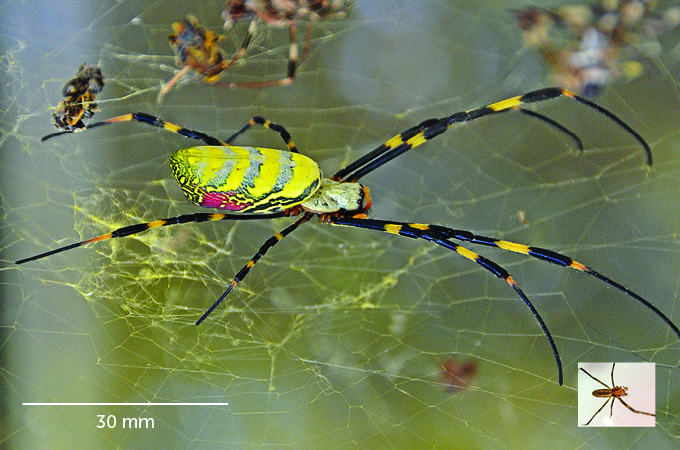Invasive jorō spiders get huge and flashy — if they’re female
Males are the other half of the story, so tiny and drab they’re often missed in oversized webs

Out in the open, female jorō spiders look eye-smacking obvious, but they’re sneaky hitchhikers. They can hide in wheel wells and under car hoods, tricks that might facilitate their spread.
UGA
Some thumbnail-sized, brown male spiders in Georgia could be miffed if they paid the least attention to humans and our news obsessions.
Recent stories have made much of “giant” jorō spiders invading North America from eastern Asia, some large enough to span your palm. Lemon yellow bands cross their backs. Bright red bits can add drama, and a softer cheesecake yellow highlights the many joints on long black legs.
The showy giants, however, are just the females of Trichonephila clavata. Males hardly get mentioned except for what they’re not: colorful or big. A he-spider hulk at 8 millimeters barely reaches half the length of small females. Even the species nickname ignores the guys. The word jorō, borrowed from Japanese, translates to such unmasculine terms as “courtesan,” “lady-in-waiting” and even “entangling or binding bride.”
Mismatched sexes are nothing new for spiders. The group shows the most extreme size differences between the sexes known among land animals, says evolutionary biologist Matjaž Kuntner of the Evolutionary Zoology Lab in Ljubljana, Slovenia. The most dramatic case Kuntner has heard of comes from Arachnura logio scorpion spiders in East Asia, with females 14.8 times the size of the males.
With such extreme size differences, mating conflicts in animals can get violent: females cannibalizing males and so on (SN: 11/13/99). As far as Kuntner knows, however, jorō spiders don’t engage in these “sexually conflicted” extremes. Males being merely half size or thereabouts might explain the relatively peaceful encounters.
When it comes to humans, these spiders don’t bother anybody who doesn’t bother them. But what a spectacle they make. “I’ve got dozens and dozens in my yard,” says ecologist Andy Davis at the University of Georgia in Athens. “One big web can be 3 or 4 feet in diameter.” Jorō spiders have lived in northeastern Georgia since at least 2014.

These new neighbors inspired Davis and undergraduate Benjamin Frick to see if the newcomers withstand chills better than an earlier invader, Trichonephila clavipes, their more tropical relative also known as the golden silk orb-weaver. (The jorō also can spin yellow-tinged silk.) The earlier arrival’s flashy females and drab males haven’t left the comfy Southeast they invaded at least 160 years ago.
Figuring out the jorō’s hardiness involves taking the spider’s pulse. But how do you do that with an arthropod with a hard exoskeleton? A spider’s heart isn’t a mammallike lump circulating blood through a closed system. The jorō sluices its bloodlike fluid through a long tube open at both ends. “Think of a garden hose,” says Davis. He has measured heart rates of monarch caterpillars, and he found a spot on a spider’s back where a keen-eyed observer can count throbs.
Female jorō spiders packed in ice to simulate chill stress kept their heart rates some 77 percent higher than the stay-put T. clavipes, tests showed. Checking jorō oxygen use showed females have about twice the metabolic rate. And about two minutes of freezing temperatures showed better female survival (74 percent versus 50 percent). Lab tests used only the conveniently big jorō females, though male ability to function in random cold snaps could matter too.
Plus jorō sightings in the Southeast so far suggest the newer arrival needs less time than its relative to make the next generation, an advantage for farther to the north. The adults don’t need to survive deep winter in any case. Mom and dad die off, in November in Georgia, and leave their hundreds of eggs packed in silk to weather the cold and storms.
Reports on the citizen-observer iNaturalist site suggest that in Georgia, jorō spiders already cover some 40,000 square kilometers, Davis and Frick report February 17 in Physiological Entomology. Sightings now stretch into Tennessee and the Carolinas. But how far the big moms and tiny dads will go and when, we’ll just have to wait and see.





